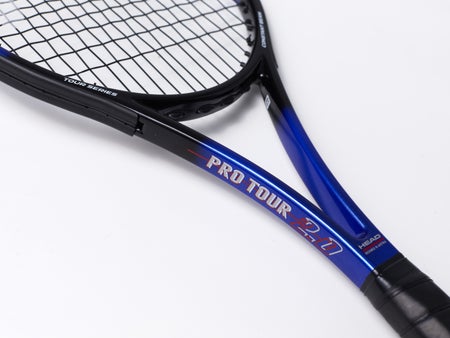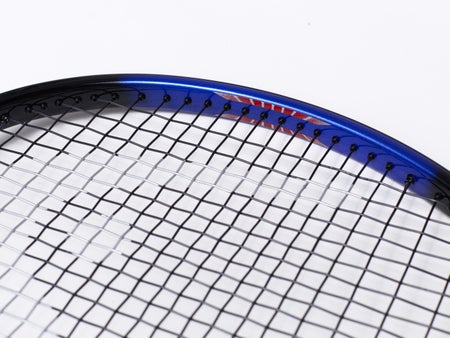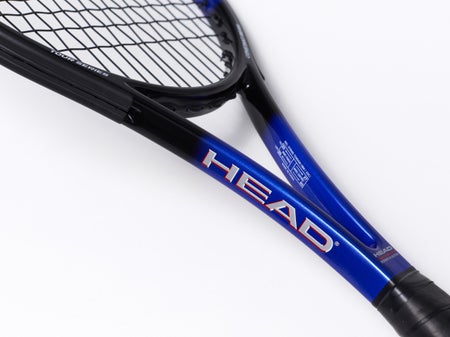Head Pro Tour 2.0 Racquet Review
| Overall | 86 |
|---|---|
| Groundstrokes | 83 |
| Volleys | 85 |
| Serves | 85 |
| Returns | 80 |
| Power | 85 |
| Control | 86 |
| Maneuverability | 75 |
| Stability | 90 |
| Comfort | 85 |
| Touch/Feel | 85 |
| Topspin | 80 |
| Slice | 90 |
Summary
Although it is impossible to state which tennis racquet is the GOAT (greatest of all time), Head's Pro Tour 280 is likely on the shortlist of a great many players. Originally launched in the early '90s as part of Head's Trisys line, the Pro Tour 280 (630 in Europe) became a staple at the elite levels of the game. The most recent version of the Pro Tour 280 is called the Pro Tour 2.0. Unlike the original Austrian-made Pro Tour 280, the 2.0 has CAP grommets, and the graphite layup lacks Twaron, a dampening aramid used by Head in the late '80s and '90s. According to our playtest team, this update also swings a tad easier than the original, and although it has its own distinct and compelling identity, the Pro Tour 2.0 doesn't forget its roots. With its dense string pattern, 20-mm beam and sub-100-square-inch head, the 2.0 gave our crew the surgical control and sublime ball feedback that has defined so many of Head's vintage player's racquets. Granted, with its 335 swingweight, this racquet can be challenging to swing, but for the advanced ball-striker who craves a rock-solid player's racquet with outstanding control and feel, the Head Pro Tour 2.0 is as good as it gets.
Upsides
- Control
- Feel
- Stability
- Comfort
Downsides
- Nothing we could agree on
Bottom Line
This updated classic feels wonderfully solid at impact, and it drops the ball on a dime.
Ability
Advanced
Groundstrokes - Score: 83
From the baseline, the Head Pro Tour 2.0 is everything you would expect a classic racquet with a pro tour pedigree to feel like: plush, precise and solid as a rock. It's safe to say that Chris, whose closet is overstuffed with vintage Head racquets, was extremely excited to try out this update and compare it to the original. He said, "I really enjoyed hitting this racquet off the ground. I found lots of plow-through power to help me drive the ball deep. The more I played with the Pro Tour 2.0, the more I got used to handling its weight and swingweight. The specs fall right at the upper end of my comfort zone, so there was some adjustment before I felt at home with the racquet. Once dialed in, I loved the control and feel I had on every shot. I felt very connected to the ball with this racquet. The Pro Tour 2.0 reminded me of Head classics. Hitting it side by side with an old Pro Tour 630, the biggest difference was this new Pro Tour 2.0 had a more manageable swingweight. While the feel was not identical, I still felt every bit in touch with my shots. I was placing my backhand slice on a dime. I was also able to hit a low, skidding slice that was tough for opponents to return. Flicking angles and lobs was easier with my regular racquet, but I got more drive and plow through from the Pro Tour 2.0. I had a lot of fun driving heavy shots down the line. The dense stringbed and classic feel gave me the confidence to swing big and aim for small targets."
Although this racquet isn't identical to the vaunted Pro Tour 280 used by some of the game's greatest legends, it does have a similar mold, and Mark simply couldn't ignore its history. He said, "Being that Guga Kuerten and Thomas Muster are two of my favorite players, I feel like I have to play well with Head's update to the classic 280/630 racquets. That said, every time Chris gave me a chance to play with one of the originals, I struggled with their high static and swingweight, so I was both nervous and excited to be brought into this playtest. Within a few baseline exchanges, I could tell that the new Pro Tour 2.0 was a little more tip-light than the earlier Austrian-made versions, and by the end of that first session my inner Muster was out. Shot power is not what I am known for, with ball placement being my predominant strategy, and the directional control I had with this stick was outstanding. As far as power goes, I have to say that the more I played with the Pro Tour 2.0, the more confident I became, and the velocity on my groundstrokes did increase without a drop in consistency."

Volleys - Score: 85
At net, the Pro Tour 2.0 delivered the considerable benefits of mass. Put simply, it doesn't get pushed around when the pace goes up. Needless to say, Mark appreciated what the stability did for his volleys. He explained, "Obviously, a lack of stability at net is not going to be a concern with a racquet weighing 12.2 ounces strung, but when paired with a 335 swingweight, maneuverability might be. Personally, the tip-light balance that Head assigned to the new Pro Tour 2.0 is such that I had no issue getting it into position on time, and its hefty swingweight helped keep most of my volleys flying straight and true."
Known for his crafty hands on court, Chris turned this solid and buttery-feeling masterpiece into a weapon at net. He said, "The Pro Tour 2.0 was a gem of a racquet at net. Rock-solid and loaded with feel, this racquet had me feeling in control of every volley. The stable response allowed me to relax and let the racquet do the work. I could punch volleys deep with pace, cut a short angle or hit a deft dropper almost at will. The only adjustment I had was on my overheads. The higher swingweight had me driving shots longer with this racquet until I got used to snapping it down faster to help spike my shots shorter in the court."

Serves - Score: 85
Our playtesters found that the Head Pro Tour 2.0 offered a controlled response and more weight behind their serves. While Chris was able to generate some pace on serve, he mostly relied on his slice on both first and second serves. He said, "I like serving with heftier racquets because they plow through the ball well and help me generate power. The weight of the Pro Tour 2.0 delivered lots of useful pace, and when I added spin, I was hitting some nice, heavy serves. My slice serve wide was working very well. I was able to add a lot of pace to that shot and get enough spin to make it drop inside the lines. The slice serve quickly became my favorite to hit with the racquet, and I mixed it in on both first and second serves with good results."
"I prefer racquets that weigh more than 320 grams on serve for easier access to pace on the ball," added Mark. "And I enjoy slightly lighter racquets (maybe 305 grams) from the baseline for the same reason: easier pace. Hence, there is usually some trade-off for me when it comes to racquet selection. That said, the Head Pro Tour 2.0 complemented my serve nicely. It did not add much in the way of velocity, but the pace I typically generate was effortless with this racquet, and as with my groundstrokes, directional control was great on serve."

Returns - Score: 80
As with the other strokes, the Pro Tour 2.0 was not without its challenges on returns, but Chris simply couldn't argue with the stability, precision and feel. He described, "When having to react quickly, it's not always possible to contact the ball perfectly, and it was on those less-than-perfect returns that I really appreciated the forgiving response of the Pro Tour 2.0. When I was better prepared and hitting cleanly, the racquet felt silky smooth. I felt confident hitting aggressively, using lots of pace and going for smaller targets. The heft of the racquet also made it perfect for redirecting the incoming pace of the serve."
For Mark, this stick felt solid and precise on his slice returns. He said, "Directional control (again) was top-notch from this racquet's heft and tight 18x20 pattern, and that made my backhand slice return one of my favorite shots to hit. On a related note, I liked this racquet enough to play with it more than once per day on a couple of occasions, and the first area of my game where it began to feel pretty heavy was on my return of serve."
Overall - Score: 86
| Technical Specifications | ||
|---|---|---|
| Length | 27 in | 69 cm |
| Head Size | 98 sq in | 632 sq cm |
| Weight | 12.1 oz | 343 gm |
| Balance Point | 12.79 in 32 cm | 6pts Head Light |
| Construction | 20mm / 20mm /20mm | |
| Composition | Graphite | |
| String Pattern | 18 Mains / 20 Crosses | |
| Babolat RDC Ratings | ||
|---|---|---|
| Score | Grade | |
| Flex Rating | 65 | Range: 0-100 |
| Swing Weight | 335 | Range: 200-400 |
| Chris' Scores | |||
|---|---|---|---|
| Power | 8.4 | Serves | 8.4 |
| Control | 8.7 | Groundstrokes | 8.6 |
| Maneuverability | 7.4 | Returns | 8.4 |
| Stability | 9.5 | Slice | 9.5 |
| Comfort | 9 | Topspin | 8 |
| Touch/Feel | 9 | Volleys | 9 |
| Overall | 8.7 | ||
| Mark's Scores | |||
|---|---|---|---|
| Power | 8.5 | Serves | 8 |
| Control | 8.5 | Groundstrokes | 7.5 |
| Maneuverability | 7.5 | Returns | 8.5 |
| Stability | 8.5 | Slice | 8 |
| Comfort | 8 | Topspin | 8 |
| Touch/Feel | 8 | Volleys | 8 |
| Overall | 8.4 | ||
Playtester Profiles
Chris: 4.5 all-court player currently using the Tecnifibre TF40 305. Chris uses a full-western forehand grip, has a fast swing style and hits a one-handed backhand.
Mark: 5.0 lefty all-court player with a one-handed backhand. He currently plays with the Head Graphene 360+ Gravity Pro.







Likes
Mark - "Head nailed this frame! This has been one of my favorite playtests, with the new Pro Tour 2.0 now becoming one of my favorite frames. Power-wise, I like that most of the energy return is coming from the Pro Tour 2.0's overall weight, which provides a predictable and comfortable response shot after shot. Lastly, I have to say that the switch to a CAP grommet was a good idea, and it helps protect the Pro Tour 2.0's (coolest ever) paint scheme."
Chris - "I love the classic feel of the Pro Tour 2.0. I've always been a fan of the feel of racquets with a full CAP grommet system. The response of this racquet reminds me of some of my favorite vintage Head offerings, such as the classic Prestiges and the Pro Tour 630. Comfort is fantastic due to the plush feel and hefty stability."
Dislikes
Chris - "While it has a lower swingweight than our vintage Pro Tour 630, I can see some players struggling with maneuverability. Having gotten used to lighter and faster-feeling racquets over the last 10-plus years, it took me some adjustment to get back in the groove with the Pro Tour 2.0."
Mark - "It did take a little while to get used to the broader Head pallet since I am accustomed to a more quadratic handle shape, but other than adding a leather grip, I do not think I would change a thing about this classic racquet."
Comparing the racquet to others they've tried, our testers said:
Mark - "Head adds another high-quality example to that small group of heavyweight tennis racquets weighing north of 12 ounces. By virtue of its weight, but not its string pattern, we can compare this Head Pro Tour 2.0 to the Wilson Pro Staff RF97 Autograph and the Yonex VCORE Pro 97 (330). And by virtue of overall weight and string pattern, but not head size, both Prince Phantom 93Ps are comparable as well. However, it is the ProKennex Ki Q + Tour Pro (325) that shares the most traits with the Head Pro Tour 2.0. Of these racquets, I am most challenged with the Pro Staff RF 97 and have the easiest time (and most fun) swinging the Phantoms and the new Pro Tour 2.0."
Chris - "I had a blast testing this racquet. Did I find it identical to the original? No. Just as impressive? Yes. I found a ton of classic feel in the Pro Tour 2.0. The level of control and precision rivaled the original for me, so much so that the most noticeable change boiled down to the differences in swingweight. Our original Pro Tour 630 has been on a stringing machine many, many more times and hit with many, many more times, so the slightly softer, deader response would likely be due to racquet fatigue. Compared to current racquets, I'd compare this Head Pro Tour 2.0 to the Head Graphene 360+ Prestige Midplus, Prince Phantom 93P 18x20 and Dunlop CX 200 Tour 18x20. The current Prestige Midplus is the closest of the bunch since it shares that CAP grommet feel, but it is slightly more flexible and has a lower weight and swingweight."